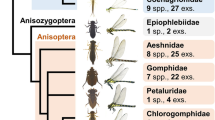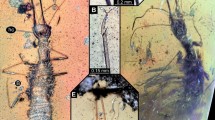Abstract
V THE development of the beautiful Comatula rosacca (Fig. 41) has been described in the “Philosophical Transactions,” by Piof. Wyville Thomson.* The larva quits the egg, as shown in Fig. 42, in the form of an oval body about 1/30 inch in length, something like a small barrel, surrounded by four bands or hoops of long vibratile hairs or ciliæ. There is also a still longer tuft of hairs at the narrower posterior end of the body. Gradually a number of minute calcareous spines and plates make their appearance (Fig. 43) in the body of this larva, and at length arrange themselves in a definite order, so as to form a bent calcareous club or rod with an enlarged head.
This is a preview of subscription content, access via your institution
Access options
Subscribe to this journal
Receive 51 print issues and online access
$199.00 per year
only $3.90 per issue
Buy this article
- Purchase on Springer Link
- Instant access to full article PDF
Prices may be subject to local taxes which are calculated during checkout
Similar content being viewed by others
References
Philosophical Transactions, 1865, vol. clv. 513.
Thomsoa, on the Embryology of the Echinodermata, Natural History Review, 1863, p. 415.
Zeits. fur Wiss. Zool., 1864, p. 228.
Introduction to Etymology, 6th Ed. i. p. 61.
Metomorphoses de l'Hommes et des Animaux, p. 113.
Darwin, Origin of Species, 4th Ed. p. 532.
Principles of Biology, Vi. p. 349.
Rights and permissions
About this article
Cite this article
LUBBOCK, J. On the Origin and Metamorphoses of Insects * . Nature 8, 107–109 (1873). https://doi.org/10.1038/008107a0
Issue Date:
DOI: https://doi.org/10.1038/008107a0
Comments
By submitting a comment you agree to abide by our Terms and Community Guidelines. If you find something abusive or that does not comply with our terms or guidelines please flag it as inappropriate.



